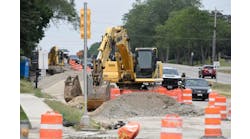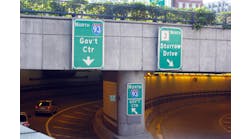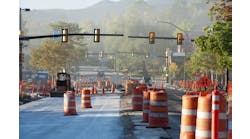December saw a flurry of action around Milwaukee, but it was not because of the Bucks basketball team or a brewery or even a flurry of snow. It was construction activity on the Marquette Interchange.
Freeway-to-freeway ramps were opened from eastbound I-94 to northbound and southbound freeways during the first week in December. The new roadway on eastbound I-94 was opened. The 13th Street exit ramp and 25th Street entrance ramp from eastbound I-94 were opened. Westbound traffic was shifted from the old I-94 westbound lanes to the new eastbound lanes, a milestone that was scheduled for next May.
“With the completion of the eastbound roadway between 25th Street and the Milwaukee River, we were able to shift the traffic onto that new roadway for eastbound and then also have the room to put westbound on there,” Brian Manthey, communications officer on the Marquette Interchange team at the Wisconsin Department of Transportation (WisDOT), told Roads & Bridges.
“The eastbound to northbound ramp also wasn’t going to be open until May.” The ramp currently is open but with only one lane. In its final configuration, it will have two lanes.
“Gaining access to that ramp and being able to shift that traffic over were the big changes,” said Manthey, “huge milestones that got hit a lot earlier than we had anticipated they would be hit.”
A big segment of the current work on the interchange is tearing down the old I-94 and I-794 structures near the center of the interchange and then rebuilding them. Because Marquette Constructors, the contractor for the core of the project, completed the traffic shift ahead of schedule, they will be able to demolish the old structure and drive piles and build piers for the new structure over winter and then get a jump on decking and paving in the spring on the westbound lanes, which are actually part of the core contract.
“The contractors have really done a great job looking at the schedule and seeing how they might be able to work ahead in some areas and take advantage of what has been a couple of mild winters,” said Manthey.
The Marquette Interchange project comprises five contracts in all. Marquette Constructors, which is a joint venture of three Wisconsin companies—Lunda Construction Co., Black River Falls; Zenith Tech Inc., Waukesha; and Edward Kraemer & Sons Inc., Plain—successfully bid on the west leg, the core and the south leg. Walsh Construction Co., Chicago, won the north leg contract. The first contract, basically a preliminary to the rest, involved reconstructing and realigning Clybourn Street between 10th Street and 16th Street and replacing the 16th Street bridge over I-94. The Clybourn Street work was completed in December 2004.
The whole project will cost about $810 million and will be the largest highway construction project in Wisconsin history.
The north leg is practically finished. The 13-in.-deep perpetual pavement has been laid. The last bits to do are entrance ramps at Kilbourn Avenue and Highland Avenue, and those probably will be completed by the time this issue is published.
The south leg is inextricable from the core work in the tangled heart of the interchange. The two contracts are scheduled to be completed at about the same time at the end of 2008.
The state has already started taking lessons from the very large Marquette Interchange project to other highway work in the region.
“We require the contractor to use a much more powerful scheduling tool,” Donald Reinbold, P.E., project development chief on the Marquette Interchange team for WisDOT, told Roads & Bridges. “That’s the only way to get this project done in an orderly manner.”
Another lesson is that the owner needs to be involved in the project: “This project is so important to [Wisconsin] that the secretary of transportation [Frank Busalacchi] is here in this building two days a week,” said Tom Hessling, project manager for CTE, the construction engineering consultants hired by WisDOT, told Roads & Bridges. “He’s personally involved with a lot of decisions that are made here on the project.”
WisDOT’s managers of day-to-day operations are Ryan Luck, David Nguyen and Reinbold.
No new sections of the interchange are scheduled to be opened from now until spring 2008 when one ramp will open and then November 2008 when the entire project should be completed . . . but meanwhile the construction project will not be dormant.
Structures on the go
“Most of the work for the next two years is structures,” said Manthey. They will be demolishing old structures and constructing new structures mostly on the south leg and the core.
Once the old structures are cleared away, the first major step in constructing the new structure is to drive piles. A few piles on the project are drilled shafts, but most are driven 14-in.-diam. piles. The soft soil of Milwaukee, especially in the Menomonee River Valley, makes it more challenging to drive piles and get sufficient load-bearing capacity.
“We’re actually monitoring and measuring each pile that we put into the ground and determining its single capacity,” said Hessling. “Typically we can achieve about 70 to 80 tons out of a pile, and here we’re getting about three times that.”
To get that performance, the crews have had to drive the piles deeper than usual for freeway structures.
“We’re going deeper, and we are measuring the resistance on each one of our piles,” said Hessling. “The thought is that we’re spending a little bit more time and money in measuring each of our piles, but for each pile we can go back and determine its exact capacity without having to speculate [based on local soil conditions]. That’s generally what we do. We believe we’re saving significant money.”
None of the old piers could be used to support the new structures because the geometry has been changed. All the left-hand entrances and exits have been shifted to the right-hand side. The turning radii have been increased so the speed limit on the ramps could be increased from 30 mph to 40 mph.
“If you’re going to go to a better geometric design so it’s more efficient and safer, you can’t” reuse piers, Reinbold said.
Hessling cited another innovative method being used.
The bridge decks are constructed of high-performance concrete with fly ash making up 15-30% of the cementitious material, slag (20-30%), a maximum water-to-cement ratio of 0.45, air content of 6% ±1.5% and a maximum slump of 4 in.
“The reason for this high-performance concrete mixture is to limit the amount of shrinkage and cracking in our concrete decks,” said Hessling.
This mix has been so successful that WisDOT has decided to eliminate the planned sacrificial overlay on the bridge decks and increase the deck thickness, according to Hessling. In the future, if the deck surface begins to deteriorate, an inch of it can be milled off and replaced, and the rebar will always be protected. The design life of the new Marquette Interchange is 75 years.
Taken to school
At the core of the Marquette Interchange is its namesake, Marquette University.
The interchange work around Marquette University is a story in itself. As good neighbors in Milwaukee and practitioners of context-sensitive design, Marquette Constructors was duty-bound to do their loud pile driving during the day and be quiet at night, especially near the university. Also, the constructors were constrained to cease noise-making activities during exam periods at the university.
The situation produced some hurried construction work. Last January, Marquette Constructors had only a two-week window after exams but before the students returned to classes from their Christmas break in which to demolish the Wisconsin Avenue bridge. They demolished the bridge deck on Jan. 6-7 and had the abutments and any other components demolished before the students returned on Jan. 17.
WisDOT and the contractors on the Milwaukee Interchange are committed to keeping at least two lanes of through traffic open during peak periods in each of the four cardinal directions throughout the construction.
“The contractor set a very ambitious schedule this year, and he’s really made it,” said Reinbold. “That actually puts some parts of this project five months ahead of schedule.” Their next milestone will come up in 2008. If they stay on target, 300,000 vehicles per year will then have a new, safer interchange with expanded ramps all on the right side, more gradual curves and longer merge distances.


